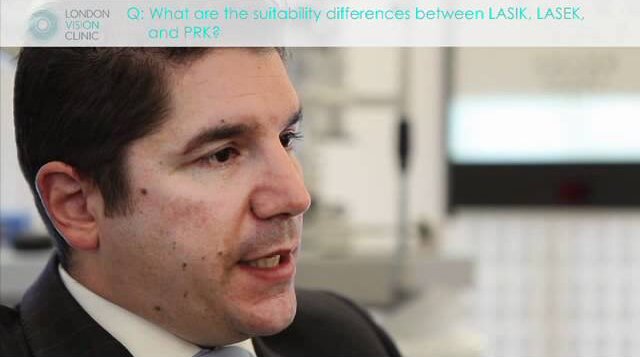What are the Suitability Differences Between LASIK, LASEK/PRK and SMILE?

If you’re considering Laser Eye Surgery and have been looking into your treatment options, you will likely have come across the following terms: LASIK, LASEK/PRK, and SMILE. These three procedures are the basis for all Laser Eye Surgery treatments (though different clinics may apply different names ). But when you’re new to the world of Laser Eye Surgery, it can be difficult to understand the differences between them, from technique to suitability.
In this article, we take a closer look at the suitability differences between LASIK, LASEK/PRK, and ReLEx SMILE – including a video by our very own expert Laser Eye Surgeon, Mr. Glenn Carp. But first, let’s explain what each of these procedures involves.
All Laser Eye Surgery procedures involve changing the shape of the cornea to correct how light is reflected into the eye. This enables your eye to more effectively focus light onto the retina (the photosensitive layer at the back of the eye). But each Laser Eye Surgery technique approaches this in a slightly different way.
What is LASIK?
LASIK is the most commonly performed Laser Eye Surgery procedure worldwide with around 100,000 people having LASIK surgery each year in the UK alone!
LASIK involves using a high-precision excimer laser to create a corneal flap on the surface of the eye. The surgeon is then able to open the flap to gain access to the corneal tissue beneath. Another laser is then used to remove the predetermined area of corneal tissue required to effectively reshape the cornea.
Once treatment is complete, the corneal flap is simply put back in place where it begins to heal almost immediately!
What is PRK/LASEK?
As Mr. Glenn Carp explains in the video below, PRK (stands for photorefractive keratomileusis) and LASEK are essentially the same thing. Both procedures employ the surface ablation approach to Laser Eye Surgery. This means that the surface layer of the cornea (the epithelium) is completely removed exposing the corneal bed beneath. From here, treatment is performed in the same way as in LASIK.
The difference between PRK and LASEK only occurs once the treatment is completed. In PRK, the corneal epithelium that was removed is discarded; a protective contact lens is placed over the treatment area while the tissue grows back – this takes roughly seven to 14 days. In LASEK, the removed portion of epithelium is put back into place. A new layer of tissue then forms underneath this layer.
What is ReLEx SMILE?
ReLEx SMILE is the most recent development in Laser Eye Surgery procedures. It is a “keyhole” procedure that minimises the invasiveness of treatment. This means that rather than removing an area of the corneal epithelium, a small tunnel is created from the surface of the eye to the corneal bed beneath.
A VisuMax laser is used to create an incision in the epithelium using several short pulses. This creates tiny bubbles in the cornea, causing the surface layer to detach from the stromal layer underneath. Through this keyhole incision, the surgeon is then able to extract the tissue and reshape the corneal bed.
How does suitability differ between procedures?
Today, we can treat around 98% of the patients we see at London Vision Clinic. This is largely thanks to our expert surgeons and their capacity to perform the most cutting-edge treatments.
While LASIK remains by far the most commonly performed treatment at our Harley Street clinic, not all patients are suitable for this procedure. In most cases, however, we can offer an alternative treatment. But what are the suitability differences between LASIK, PRK/LASEK, and ReLEx SMILE?

As Mr. Glenn Carp explains in the video above, in cases where a patient is suitable for both LASIK and PRK/LASEK, we will usually recommend LASIK due to the more favourable healing times associated with this procedure. However, factors such as the presence of extensive corneal scars, or having thin corneas can make a patient unsuitable for LASIK.
In these cases, LASEK or PRK may be a better option. However, for patients who experience slow-healing wounds or who have inflammatory conditions, surface procedures may not be a good option. Furthermore, a patient’s lifestyle or job (for example, participating in high-contact sports) can also influence the surgeon’s recommendation.
Improving access to Laser Eye Surgery for more patients
Patients with thinner corneas or higher prescriptions may have once been told that they are unsuitable for Laser Eye Surgery. When treating a higher prescription, more tissue needs to be removed from the cornea to achieve the desired outcomes. Therefore, to perform LASIK, the cornea needs to be thick enough to allow surgeons to create a flap and reshape the tissue underneath. However, the introduction of ReLEx SMILE means that even patients with thinner corneas may be suitable for higher-profile treatments.
ReLEx is also associated with improved recovery times and a reduced risk of dry eyes – a common side effect during the Laser Eye Surgery recovery period.
At London Vision Clinic, we take every aspect of your eye health, general health and pre-operative prescription into account when determining your suitability for Laser Eye Surgery. Our extensive screening process allows us to offer the most suitable treatment option for you – even if this means we are unable to treat you.
If you have any further questions about your suitability for Laser Eye Surgery, get in touch with one of our friendly clinic coordinators or Book a Consultation today.


